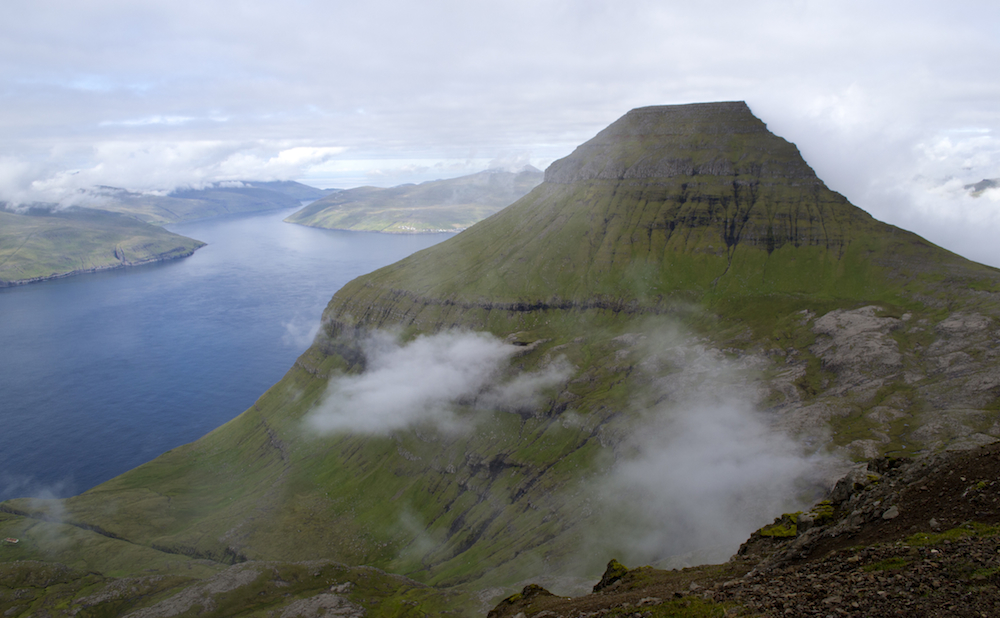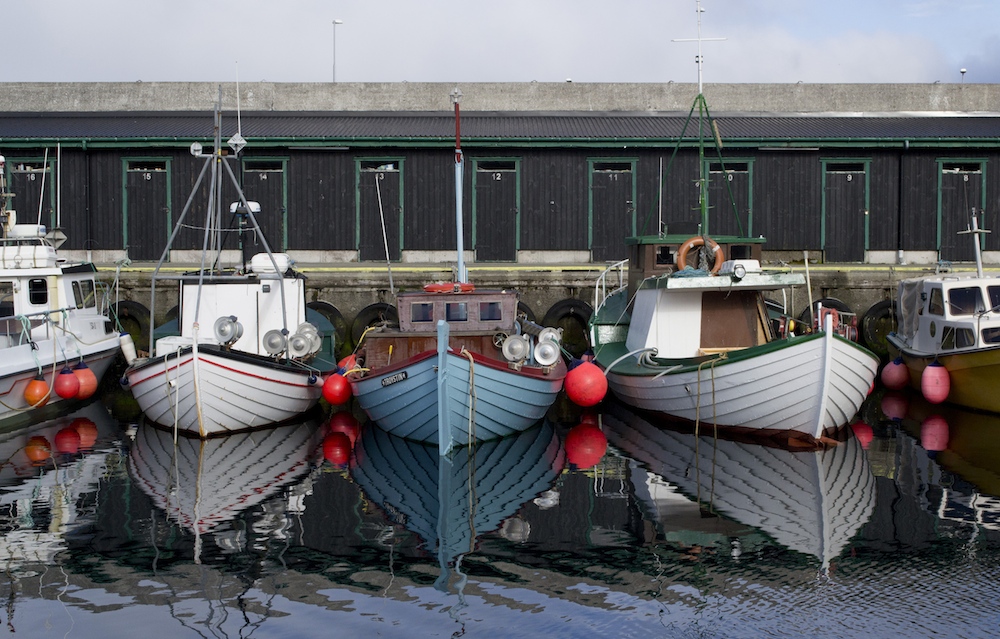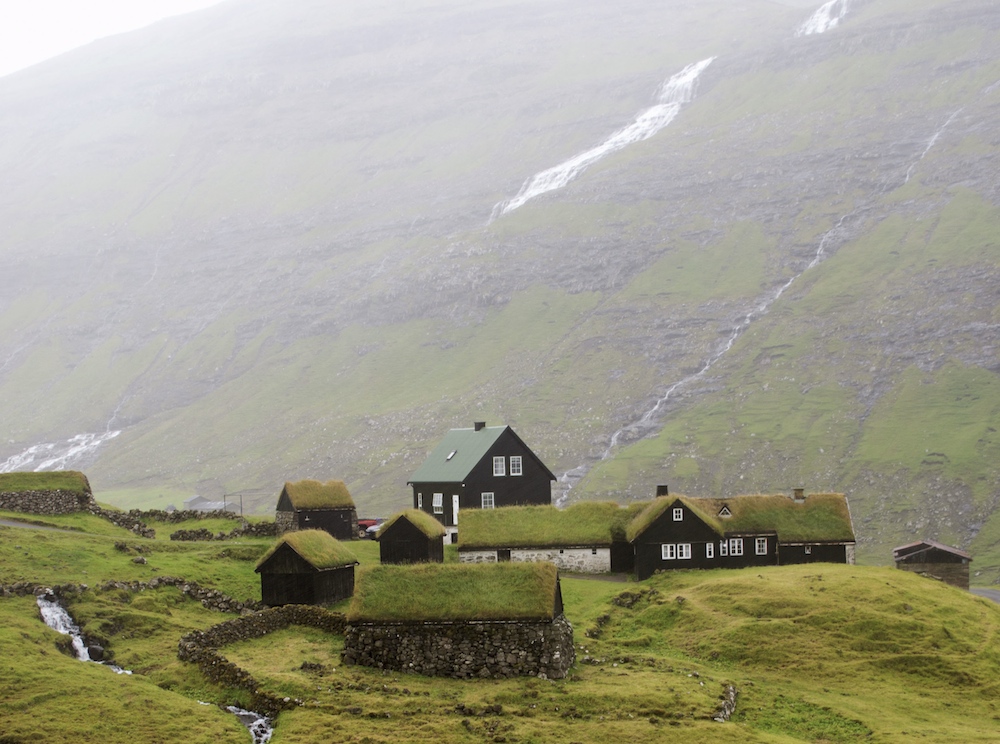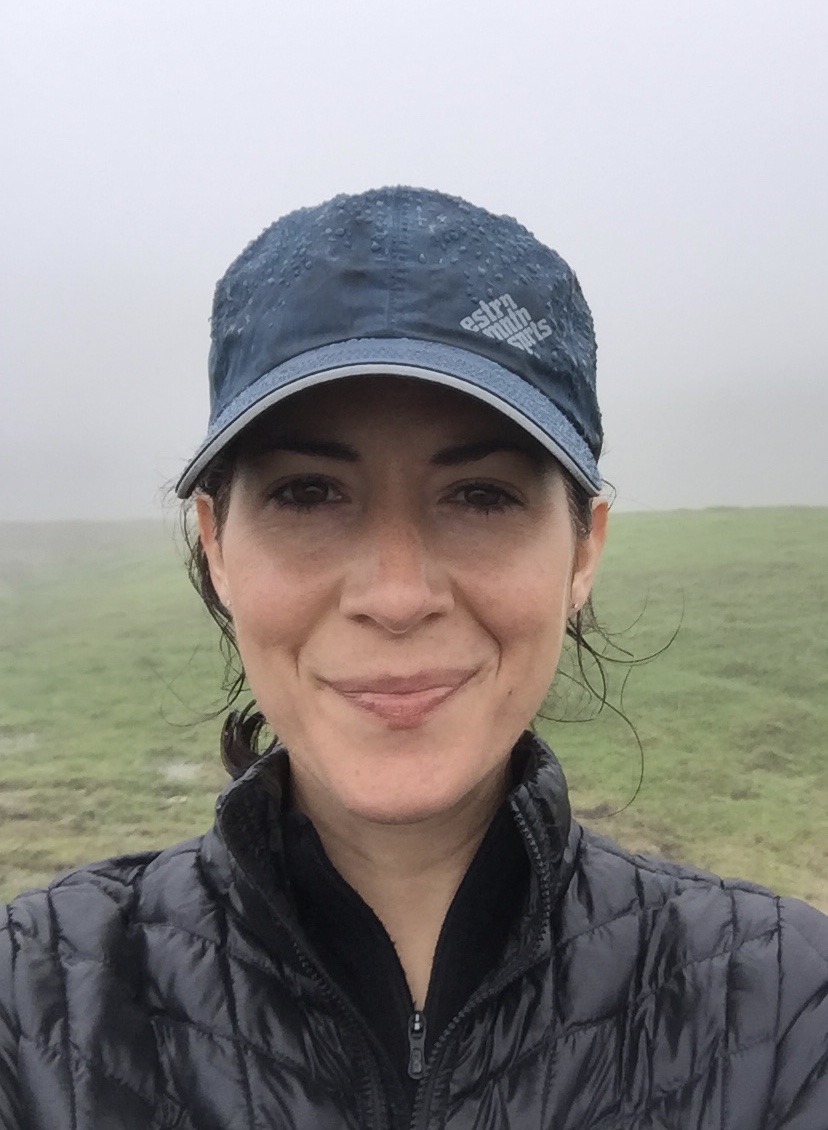Essay by Catherine Owens
A Trip to the Faroe Islands Sparks Change on a Human Scale

It was love at first sight: a single photograph at the bottom of a promotional email for outdoor gear. I bought a plane ticket in August 2017, and now there I was, seatbelt securely fastened, tray table in the upright position, eyes straining through billowing layers of white to catch my first amorous glimpse.
Like any good millennial, I’d stalked my new amour on the Internet before we met in person. I’d spent hours ogling image after image of lonely cliffs rising through the fog and Technicolor meadows swirling across mountain tops like peanut butter on toast.
The sheer wildness of the Faroe Islands, north of Scotland and politically affiliated with Denmark, had captivated my attention. Its landscape was sublimely different from my urban environment at home in Boston, and the photos alone gave me hope that such untouched places still exist in the world.
Stories of environmental devastation are everywhere. If asked, I’ll say truthfully that I believe climate change is humanity's highest priority. I worry about it constantly, which is why I'm so perplexed that when it comes to taking action to prevent it, my concern seems to peter out.
Until my visit to the Faroe Islands taught me the value of awe.
• • •
I felt like I’d been duped. My ten-year-old self believed that adults always did the right thing—but clear-cutting the rainforest was definitely not the right thing. In the 1990s, I was a girl who had posters of fluffy jaguar cubs and wide-eyed monkeys lining the walls of her bedroom, and I distinctly remember the mixture of slow-burning rage and sorrow that accompanied my first realization that humans could harm such creatures.
As an adult, I’ve found outlets for my environmentalist leanings in a variety of part-time jobs, volunteer opportunities, and graduate studies. But in recent years, the fever pitch we’ve reached over climate change and its related tragedies has paradoxically left me feeling more numb than enraged—overwhelmed to the point of inaction.
It’s not like I do nothing for the environment, it’s just, well—I diligently compost all the food I’ve let languish in my fridge until it’s inedible. I walk or ride my bike around Boston, but only when I’m not driving my husband’s sports car. I sweater-up every October to see how long I can go before turning on the heat, but it’s a different story come January, when I can’t resist the glow of a roaring fire. I’m sitting by one as I write this, in fact, feeling warm. And guilty. And warm.
I’m not alone in my lack of consistent action. The authors of a 2017 report from the American Psychological Association (APA) titled Mental Health and Our Changing Climate argue that people are more likely to engage in climate change solutions if they can see the relevance to their own well-being. But for many Americans—myself included—finding and maintaining a connection to something so large through the spectral affairs of daily life remains elusive.
“It’s one thing to look at your backyard and see pollution,” an expert on national climate-change policy (who requested anonymity) told me in a recent phone interview. “But when you think of something more abstract, that’s happening on a global scale—like glaciers melting and coral reefs bleaching—it’s difficult to connect to it in a way that makes you feel like you can do something.”
One outcome, according to the APA report, is that a growing number of Americans experience ecoanxiety—defined as a “chronic fear of environmental doom”—because they feel they can't do anything to stop climate change. This ecoanxiety, in turn, can make people desensitized, resigned, and cynical. It can even cause repression and denial—the twin henchmen of inaction.
If my conversations with friends and colleagues over the last couple years are any indication, these feelings resonate with many of us. It’s certainly the state I was in when I arrived in the Faroe Islands.
But as I hiked day after day, breathing in the sky and mountains and mist, my anxiety calmed. I felt more connected to the wider earth around me. I began to reconnect to the responsibility I have to act and to my own ability to make changes in my daily life. I wondered if my experience was unique or spoke to something larger. Even a hint of an antidote to my growing ecoanxiety felt refreshing, a way to reset and rethink the helplessness it’s so hard to fight.

• • •
My face was glued to the window as the plane taxied down the runway in Vágar, about thirty miles west of the Faroese capital of Tórshavn where I stayed for the week. I’d arrived at the tail end of several days of rain, and there was water everywhere—in impromptu pools on the ground, in quivering droplets on the breeze, and before long, in the interstices of the weave of my jeans.
As I sped away from the airport in a rented Peugeot, a fairytale world unfolded before me: Waterfalls meandered as spontaneously as sunbeams, emerald smears clung to rugged cliffs as if holding on for dear life, and midnight-blue waters lapped at obsidian shores. It was a guilty pleasure just to look, as if I’d mistakenly wandered into an ambrosial land never intended for mortal eyes.
In his 2008 book The Spirituality of Nature, artist Jim Kalnin writes, “there are times when the beauty and tranquility of [natural] places allow us to see the world and our part in it from a completely different perspective.”
This was one of those times. Looking out over undulating, verdant hills that braided earth into sea, I felt my smallness. I was an insignificant witness to the vastness of this land. For a moment, it seemed impossible that I, in my tiny human form, could have any effect on a body so grand. Then a wave of reverence flipped this thought on its head: Of course I have an effect, and an outsized one at that. Packaging, food wrappers, to-go cups, car exhaust—I leave indelible traces of myself everywhere I go.
Such sensations of awe feel meteoric, as striking in their power as in their brevity. But recent research suggests they may confer more benefits to society than the ephemeral jolt I experienced.
In “Awe, the Small Self, and Prosocial Behavior,” a 2015 paper in the Journal of Personality and Social Psychology, its five authors observe that “first-hand accounts of awe…often center upon two themes: the feeling of being diminished in the presence of something greater than the self, and the motivation to be good to others.” They detail a series of five randomized controlled studies conducted with more than two thousand subjects across the United States.
In each study, participants were exposed to a stimulus—a clip from the BBC’s documentary series Planet Earth, for instance, or a slow-motion film of colored liquid being dropped into milk—all of which had reliably sparked awe (or comparison emotions like amusement or pride) as reported in previous studies.
Researchers then recorded what participants would do in hypothetical and real-life situations: Did they say they would return a hypothetically misdelivered envelope of cash? How would they divvy up raffle tickets that could win them real money? How willing were they to help pick up a box of real pens “accidentally” spilled by a researcher?
In all five studies, subjects in the groups exposed to awe-inspiring scenes more often acted generously, helpfully, and ethically in the test situations. “Awe” subjects were also much more likely to agree with statements such as “I feel like I am part of a greater whole” and “in the grand scheme of things, my own issues and concerns do not matter as much.”
I’m ordinarily skeptical of social science research that investigates fleeting, complicated emotions like awe—even studies like these, which took pains to use large sample sizes and externally validated testing techniques. But standing before grand vistas in the Faroe Islands, I felt this firsthand. Hiking along cliff edges and misty mountainsides, I felt small and insignificant before the wonders of our planet, inspired anew to make decisions that take into account the world beyond my doorstep.
• • •
A year now separates me from the awe-inspiring landscapes I’m writing about, and I won’t claim I’ve reached climate-crusader status; it’s nothing so grand as that. But I carry the awe with me everywhere, tucked into folds of memory, ready to pull out in moments of decision. Should I Uber to dinner tonight or walk to the subway? Should I seek warmth in the fireplace or under a blanket? I don’t always make the right choice, but I do make the right choice more often now than I did before.
What’s more, facing the challenge of climate change in small ways every day has given me courage to pursue larger actions. Recently, I’ve shifted the focus of my work as an artist and writer to encompass environmental issues. I’ve been contemplating this since I first fell in love with jaguars and monkeys, but I previously struggled to incorporate these ideas into my chalk murals and illustrations.
In “Last Call,” his 2010 essay in Harper’s, Edward Hoagland puts it this way:
Never mind, for a moment, whether the seas will rise—will we capsize? I don’t mean fail to produce sufficient fertilizer to grow protein for a humanity cheek by jowl, but our whole catamaran—animal, yet ethical—as humanity.
I believe in humanity’s ability to stay afloat. But I also believe ecoanxiety and its repercussions are steering our catamaran in the wrong direction. If we truly want to turn it around, we have to find an ally that’s as large and intangible as the problem itself. Let’s start by seeking awe instead of bathing ourselves in bad news. Sit quietly in a park or forest, spend an evening watching episodes of Planet Earth, gaze up at the stars on a cloudless night—do anything that allows you to lose yourself in the sensation that you’re but a miniscule part of it all.
Then let’s get to work.

Publishing Information
- Mental Health and Our Changing Climate: Impacts, Implications, and Guidance by Susan Clayton Whitmore-Williams, Christie Manning, Kirra Krygsman, and Meighan Speiser (American Psychological Association and ecoAmerica, 2017).
- The Spirituality of Nature by Jim Kalnin (Northstone, 2008).
- “Awe, the Small Self, and Prosocial Behavior” by Paul K. Kiff, Pia Dietze, Matthew Feinberg, Daniel M. Stancato, and Dacher Keltner, Journal of Personality and Social Psychology 108(6), 2015.
- “Last Call” by Edward Hoagland, Harper’s, May 2010.
- Phone interview by author with national climate-change policy expert, January 19, 2018. This expert requested anonymity because of the current administration’s antithetical stance on the subject.
Art Information
- Photos of the Faroe Islands © Catherine Owens; used by permission.
 Catherine Owens is an accidental artist, intentional traveler, and aspiring writer in Boston. On her new platform, Quarry & Reseed, she writes about environmental sustainability and conservation issues that relate to food, art, and design.
Catherine Owens is an accidental artist, intentional traveler, and aspiring writer in Boston. On her new platform, Quarry & Reseed, she writes about environmental sustainability and conservation issues that relate to food, art, and design.
To read more of her work, visit Quarry & Reseed or follow her on Twitter @QReseed. To view Catherine’s artwork, visit Chalk & Ink.
